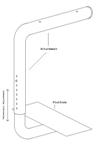

A provisional patent application by Peter Leong. Copyright © 2006.
The Foot Swing Input (FSI) is a means of using the knee joint to control an input signal to a computer or machine. It also acts as an effective foot rest and light excercise apparatus.
A typical arrangement for computer input is a keyboard and mouse, and perhaps a joystick. This arrangement suffers from a number of problems including:
- loss of productivity and lapses in input while the user removes a hand from one device and positions it on the other
- the hand operating the joystick or mouse cannot simultaneously type keys and move the mouse or joystick
- a Repetitive Stress Injury (RSI) of the wrist may result from constant use of a mouse in a non-ergonomic fashion. This disorder can be relieved and / or avoided by using the legs which are far more durable
Existing foot controlled mice typically rest on the floor and do not utilise significant movement of the knee to provide input. Other foot controlled devices are buttons only and do not provide joystick nor mouse pointer control.
The Foot Swing Input provides a mechanism for the user to control a signal to a computer or machine using a natural, low-stress extension of the knee. It solves the above problems by freeing the hands to provide dedicated typing input and eliminating the need for constant use of the mouse or joystick.
The FSI in operated whilst seated at a desk or table. The users foot rests, with the weight of the leg, on a foot-sized platform that is suspended, via an attachment, from the underside or edge of the desk working area. The platform and attachment can move freely in a swinging motion forward and back with the extension and and relaxation of the knee. A sensor is used to measure the angle of the device relative to the desk. See Fig_1_Usage.JPG and Fig_2_Device.JPG.
Features of this device include:
- the rigid attachment is connected to the lateral (outer) side of the foot platform and travels upward to the underside of the desk, at which point it turns and travels along the underside of the desk over the lap of the leg
- the horizontal upper portion of the attachment is connected at two articulate joints to the underside or edge of the desk
- telescopic adjustment of the vertical portion of the attachment
One can use this invention to control a 'throttle' for playing a computer game. When both legs are used, one can provide an input similar to a joystick where each leg controls an axis on a two dimensional plane. For example, the left foot might control the Y-axis and the right foot might control the X-axis.
If, however, these axes are oriented in a diagonal direction then symmetry in the movement of the legs can be achieved. This symmetry of movement enables a more intuitive use of the legs. See Fig_3_Control_Motion.JPG.
A computer program may also be used to interpret the resulting vector and then move a mouse pointer at a corresponding velocity across the computer display.
The use of pulleys and line can be used to transfer the movement of an FSI to a conventional joystick. However, a dedicated hardware device is preferred for measuring and combining the motion of a pair of FSI. This device would then appear and act like a conventional joystick or mouse as far as the computer is concerned.
Alternative configurations of this invention include:
- a bike pedal style movement of the platform around a horizontal axis beneath the foot
- joining of the FSI to a fixture mounted on the underside or edge of the desk
- a free standing apparatus from which the FSI can hang
- a single articulated joint between the desk and the FSI to enable additional degrees of movement (IE: lateral and twisting movement)
- arrangements with stirrups and rope
- the use of an alternative resistance other than the weight of the users leg and foot such as springs or weights
- a similar device where the upper portion of the attachment turns outward away from the lap instead of over the lap